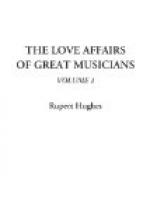For eighteen years Constanze mourned her husband. Indeed, she never ceased to mourn him. But, after nearly a score of years, in 1809, when she had reached the age of forty-five, she was sought in marriage by a councillor from Denmark, George Nicolaus von Nissen. He undertook the education of her two boys, and won her hand. She lived with him in Copenhagen till 1820, when she returned to Salzburg. The quaintness of this affair should not blind us to the unusual depth of affection it revealed. Constanze inspired even her new husband with such devotion to Mozart’s fame that Nissen wrote a biography of his predecessor in her affections.
There cannot be many instances of a second husband writing a eulogistic biography of the first, but Nissen wrote his with a candour and enthusiasm that spoke volumes for his goodness and for that of Constanze. He died, however, before the biography was completed, and Constanze finished it herself. She includes in the publication a portrait of Nissen and a tender tribute to his memory. Many of the most beautiful anecdotes of Mozart’s life we owe to Nissen’s gentle unjealousy, and Constanze could frankly sign herself “widow of Staatsrath Nissen, previously widow of Mozart.”
She includes an anonymous poem on Mozart’s death, beginning:
“Wo ist dein Grab? Wo duften die Cypressen?”
Which is in its way evidence enough that she did not hold herself, or her “indifference,” responsible for the dingy entombment of this genius, and the disappearance of his grave. As her last words to the public she says: “May the reader accept this apologetic, this intimate love-offering, in the spirit in which it is given. Salzburg, 1828.” What reader can refuse this sympathy to one who felt and gave so much to one who craved sympathy as the very food of his soul?
When Constanze was elderly and the second time widowed, she was, according to Crowest, visited by an English lady and her husband—an eminent musician—both of whom were anxious to converse with the relict of the great master. Notwithstanding the years that had passed, Frau Nissen’s enthusiasm for her first husband was far from extinguished. She was much affected at the regard which the visitors showed for his memory, and willingly entered into conversation about him.
“Mozart,” she said, “loved all the arts and possessed a taste for most of them. He could draw, and was an excellent dancer. He was generally cheerful and in good humour; rarely melancholy, though sometimes pensive. Indeed,” she continued, “he was an angel on earth, and is one in heaven now.”




